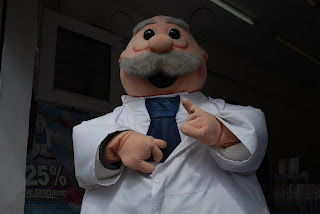
Americans are obsessed about safety but they probably don't realize that. It's second nature to get into a car, buckle the seatbelt, start the motor, and then drive. For the most part we turn on our turn signals, stop when pedestrians are crossing, and don't go too fast in neighborhoods. Mexico is different.
As you can see, there are various modes of transportation, none of which are particularly safe. The big busses that run between Sahuayo and Jaquilpan, the town just south of Sahuayo, are the safest.
The Volkswagen vans, combis, are not. The door regularly slides open while the vehicle is moving. There are no seat belts, nor cushions on the seats. That's what you get for nine pesos, round trip. I take the combi to Wal-Mart (Bodega Aurrera) every Saturday. They're efficient but I don't feel safe in them.
There seems to be no age minimum to drive. Kids ride mopeds in their parents' laps. Teenagers drive with no helmets. People sit on the back of motorcycles with no
seat belt. It's not uncommon for people to sit in the back of
pick up trucks.Pollution doesn't bother Mexicans. I can't imagine there are emissions tests here. Cars belch excessive amounts of CO2 and NOX into the air. Some cars have no catylitic converters. Old pick up trucks release tons of fumes into the air. The highway, carretara, is a nasty place to breath air. Mexico is about 30 years behind the United States in terms of safety and pollution.

Bicycles are also popular in Mexico. Many people ride old, rusty bicycles as a convenient way to get around. Nobody wears a helmet.
The rich folks drive Linclons, BMWs, Lexuses, Cadillacs, and other late-model cars.
VW Bugs are common too. Some serve as publicity cars (Auto Publicidades). They annoy me. They drive around constantly, advertising for any company that will pay for a slot. Gas trucks also roam the city, constantly reminding people that they're selling gas. All of this would be noise pollution in the United States. I don't know if Sahuayans put up with it, or have learned to ignore it. I have yet to ignore it.
 Although Sahuayo is a small Mexican town that you can barely locate on a map, American influence is still pervasive, as these pictures show. Vendors sell American movies and magazines in the streets, and I hear American music blasting in the cars.
Although Sahuayo is a small Mexican town that you can barely locate on a map, American influence is still pervasive, as these pictures show. Vendors sell American movies and magazines in the streets, and I hear American music blasting in the cars.

 Here's the school I work at, CulturLingua. It's on Calle (Miguel) Hidalgo. As you can see, it's not much. There's an open-air patio that gets wet when it rains. Now that it’s winter, there’s no respite from the cold air outside. There are two gates at the front. Ricardo, the coordinator, has a computer, but no internet access. There are few resources here: one printer, one computer, no internet, no copiers, and very few office supplies. We have CD players and white boards in the room. There are only five classrooms, and one functional toliet.
Here's the school I work at, CulturLingua. It's on Calle (Miguel) Hidalgo. As you can see, it's not much. There's an open-air patio that gets wet when it rains. Now that it’s winter, there’s no respite from the cold air outside. There are two gates at the front. Ricardo, the coordinator, has a computer, but no internet access. There are few resources here: one printer, one computer, no internet, no copiers, and very few office supplies. We have CD players and white boards in the room. There are only five classrooms, and one functional toliet.











































